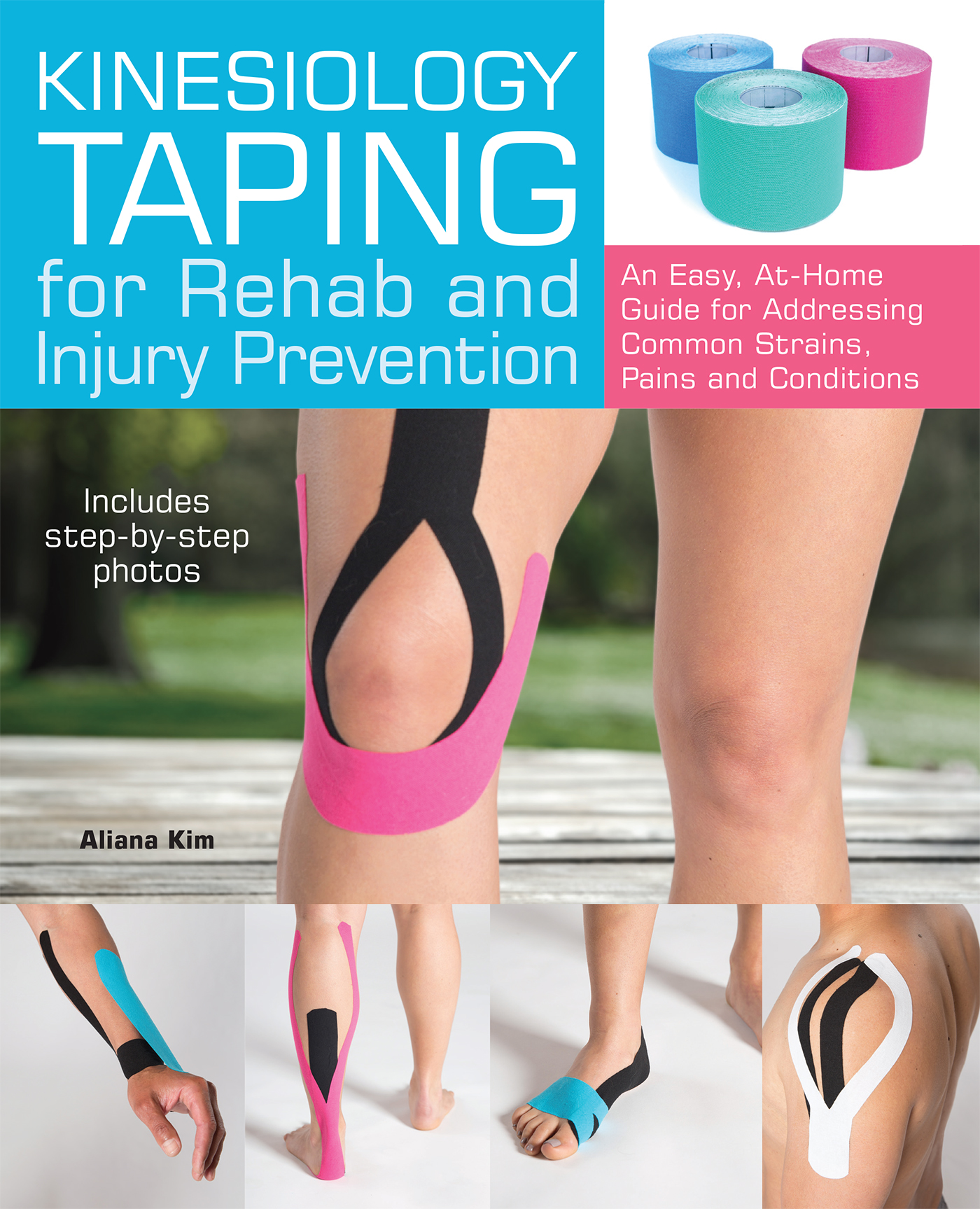CONTENTS
Guide
Kinesiology Taping for Rehab and Injury Prevention
An Easy, At-Home Guide for Addressing Common Strains, Pains and Conditions
Includes step-by-step photos
Aliana Kim
Text copyright 2016 Aliana Kim. Design and concept copyright 2016 Ulysses Press and its licensors. Photographs copyright 2016 Rapt Productions except as noted below. All rights reserved. Any unauthorized duplication in whole or in part or dissemination of this edition by any means (including but not limited to photocopying, electronic devices, digital versions, and the internet) will be prosecuted to the fullest extent of the law.
Published in the United States by
Ulysses Press
P.O. Box 3440
Berkeley, CA 94703
www.ulyssespress.com
ISBN13: 978-1-61243-553-4
ISBN13: 978-1-61243-582-4 (Ebook)
Library of Congress Control Number 2015952127
Acquisitions editor: Casie Vogel
Managing editor: Claire Chun
Editor: Lily Chou
Proofreader: Renee Rutledge
Cover design: what!design @ whatweb.com
Interior design: Jake Flaherty
Interior images: Rapt Productions except from Peter Hermes Furian
Cover images: Rapt Productions except rolls of tape nito/shutterstock.com; man in anatomical position Cliparea | Custom Media/shutterstock.com
Models: Nadia Qabazard, Michael Toy
Index: Sayre Van Young
Please note: This book has been written and published strictly for informational purposes, and in no way should be used as a substitute for consultation with health care professionals. You should not consider educational material herein to be the practice of medicine or to replace consultation with a physician or other medical practitioner. The author and publisher are providing you with information in this work so that you can have the knowledge and can choose, at your own risk, to act on that knowledge. The author and publisher also urge all readers to be aware of their health status and to consult health care professionals before beginning any health program.
This book is independently authored and published. No sponsorship or endorsement of this book by, and no affiliation with any tape, including Kinesio tape, or any other trademarked brands or products mentioned or pictured, is claimed or suggested. All trademarks that appear in this book belong to their respective owners and are used here for informational purposes only. The author and publisher encourage readers to patronize the quality brands and other products mentioned and pictured in this book.
To my husband, who has been my biggest supporter. Also, to my clients, who have taught me so much about real-life application over the years that this book would not be possible without them.
WHAT IS KINESIOLOGY TAPING?
Kinesiology taping is used as temporary treatment for acute and subacute conditions. It can be used to aid those with chronic pain conditions such as arthritis, tennis elbow, patellar tracking syndrome, ankle sprains, carpal tunnel, inflammation, general pain, and structural misalignment. Kinesiology taping can also be used to prevent injuries and help return the body to homeostasis in cases of lymphatic damage like inflammation.
BACKGROUND
Kinesiology taping was developed by Dr. Kenzo Kase in 1979. A licensed chiropractor as well as a licensed acupuncturist, Dr. Kase saw that manual therapy was extremely effective for pain management and overall health, but the effects were usually temporary. He developed kinesiology taping in order to increase the effectiveness of manual therapy. Kinesiology taping was introduced in the United States in 1995, and then introduced to Europe in 1996.
The usage of kinesiology taping varies. People whove had surgeries use it in order to regain some structural function and alignment in the body. Athletes use kinesiology taping in order to keep the body in proper alignment; they also treat it as a preventative measure in regard to injuries. Everyday people use kinesiology taping for maintenance, pain, and proper alignment.
It can be difficult to tape yourself so many turn to doctors of physical therapy (DPT), athletic trainers, massage therapists, kinesiologists, chiropractors, sports medicine physicians, physical therapy assistants, and acupuncturists, just to name a few. Kinesiology taping is really meant for everyone, not just elite athletes. Its especially beneficial for those who are going through some sort of rehabilitation due to injury.
The science of kinesiology taping is still ongoing. There have been studies to support kinesiology taping, but there are also studies that suggest its nothing more than the placebo effect. The sample sizes tend to be fairly small and, until more research is completed about this therapy, the scientific community will be 50/50 on the subject.
In my own personal practice, it has been extremely useful, specifically when used post-manual therapy. Having worked with a variety of clients, including gunshot victims, Ive noticed a drastic difference, especially with lymphatic taping in severely inflamed areas. Until more substantial information comes out in regard to kinesiology taping, it really depends on your own personal practice. I highly recommend that all taping techniques follow some sort of manual therapy. In my own experience, Ive gotten the best results this way. It can be beneficial to use taping before a competition as a preventative measure, but it really only turns into a Band-Aid if serious injury occurs.
SAFETY
Before taping, its important to know that its fairly new and there isnt a lot of research on the subject. Many, however, have felt the benefits of taping when working with other trained professionals. Taping should always be used in conjunction with other rehabilitative care, such as seeing a physical therapist, chiropractor, massage therapist, or athletic trainer.
Kinesiology taping was never supposed to be used alone for any condition. It was created to prolong care during chiropractic treatment plans. So its safe to say that if you decide to tape yourself (say, for a chronic condition), be sure to work with a professional rehabilitation therapist first.
This work is meant to enhance the work of your therapist, not replace actual hands-on work with your therapist. Doing soft tissue work makes you feel amazing at the moment but sometimes the effects dont last. Kinesiology taping strives to prolong the effects of soft tissue work.
Disclaimer: None of the taping techniques in this book are meant to treat, diagnose, or cure any disease or ailment. They are purely therapeutic and meant only for educational purposes, and its highly advised that you seek the help of your physician for any conditions in this book or any condition that causes severe pain, inflammation, neuropathy, hematomas, heat to the area, and bruising. Its always advised to speak to your doctor before attempting to tape yourself, and its important to check for any underlying conditions before taping.
I hope these basic techniques help you get a grasp of what taping is about. I wish you luck on your taping journey and, as always, be careful and speak to your provider if you choose to use kinesiology taping.
CHAPTER 1 BASIC TERMS
In order to perform kinesiology taping on yourself, there are a few terms you need to know. In this chapter, well go over basic anatomy and kinesiology terms that will help you on your journey to self-taping.






